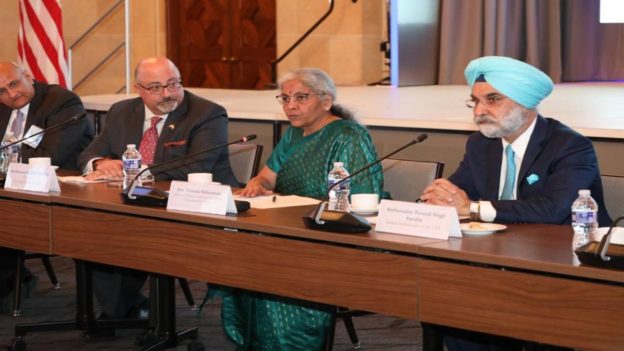India’s journey from the 10th largest economy in dollar terms in 2014 to becoming the world’s 5th largest economy has been one of steady acceleration in growth amidst global and domestic challenges, she said on Monday during a fireside chat at the Peterson Institute for International Economics.
India’s structural reforms approach has ensured that it remains a globally attractive destination for investment and the country is well-positioned in the global economy, allowing it to grow briskly, possibly faster, in the coming years, Union Finance Minister Nirmala Sitharaman has said.
India’s journey from the 10th largest economy in dollar terms in 2014 to becoming the world’s 5th largest economy has been one of steady acceleration in growth amidst global and domestic challenges, she said on Monday during a fireside chat at the Peterson Institute for International Economics. Sitharaman said India has integrated its economy with global trade and financial flows while ensuring a higher standard of living and improved quality of life for Indian households.
“The structural reforms approach has ensured that India remains a globally attractive destination for investment, supported by the rising domestic consumption of the middle class, robust infrastructure push by the government, sustainable fiscal health and a vibrant class of domestic institutional investors,” she said.
In her prepared remarks on ‘Resilience of the Indian Economy amidst tightening of financial conditions’, she said that India is well-positioned in the global economy, allowing it to grow briskly, possibly faster, in the coming years due to conscious policy choices in the last nine years.
Noting that policymakers had no fixed template to fall back on when dealing with the pandemic-induced economic setbacks, navigating the ongoing geo-political crisis, and tightening financial conditions, Sitharaman said the last few years have been unique for India since the domestic financial institutions’ balance sheet problems and the external shocks since 2020 required structural reforms to build foundational resilience.
“Decoupling from the standard economic policy prescriptions while developing a model unique to the Indian context has enabled India to stand out today and establish a firm path to recovery and economic growth,” she said. When advanced economies enjoyed relatively accommodative monetary policy in the second decade of the millennium, the Indian economy underwent a period of tight financial conditions.
During the pandemic, when the dominant policy advice was to provide open-ended monetary and fiscal stimulus, the Indian government chose a more cautious route, carefully managing resources and responding to situations on a priority basis, said the minister. “This calibrated approach allowed us to take advantage of the opportunity presented by the pandemic to implement structural reforms in the form of the Self-Reliance package (Aatmanirbhar Bharat) under the visionary leadership of our Prime Minister Narendra Modi,” she said.
India has prioritised macroeconomic stability while ensuring inclusive growth by expanding the size and scope of budgeted expenditure, simultaneously, it undertook wide-ranging structural reforms such as introducing the Goods and Services Tax, Insolvency and Bankruptcy Code and corporate tax rationalisation.
“Along with financial integration, we ensured financial inclusion by developing an affordable and advanced public digital infrastructure, with the formalisation of the Indian economy and wider tax base being other benefits,” she said.
India, she asserted, is better placed with muted spillover effects from stressed financial conditions in the West. Notwithstanding the intermittent corrections due to excessive volatility in global financial markets, the INR remains stable relative to its counterparts.
Despite foreign portfolio outflows as investors rushed to seek safer assets, the Indian Financial Sector has not displayed signs of volatility or stress due to an improved investment environment, led by declining Non Performing Asset (NPA) levels across the banking sector and stronger balance sheets in financial and non-financial private entities, Sitharaman said.
https://www.financialexpress.com/economy/india-remains-a-globally-attractive-destination-for-investment-due-to-structural-reforms-fm-nirmala-sitharaman/3041859/





